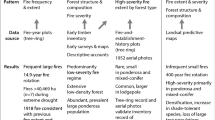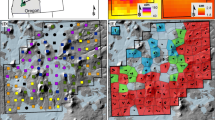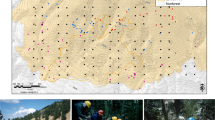Abstract
Context
Spatial patterns of fire severity are influenced by fire-vegetation patch dynamics and topography. Since the late nineteenth century, fire exclusion has increased fuels and recent fire severity patterns may diverge from historical patterns.
Objectives
We used data from a 2008 wildfire burning in a landscape with known nineteenth century fire severity patterns to answer the following questions: (1) Were the spatial patterns of fire severity and fire effects after the 2008 fire similar to those in the late nineteenth century? (2) What factors were most important in controlling spatial patterns of fire severity in 2008?
Methods
Fire severity patterns in the late nineteenth century were identified by Beaty and Taylor (J Veg Sci 18:879, 2001) using dendroecology. Plots were remeasured after the 2008 fire and geospatial layers of vegetation type, topography, fire weather, daily fire extent and fire severity were used to identify controls on 2008 fire severity.
Results
Fire severity in 2008 varied in ways similar to the nineteenth century. Tree mortality and bark char in plots were lowest on lower slopes and southwest facing slopes, intermediate on middle slopes, and highest on upper slopes and northeast slopes. At the landscape scale, vegetation type, elevation, slope aspect, slope position and weather were the variables controlling fire severity.
Conclusions
Spatial patterns of fire severity persisted, despite more than a century of fire exclusion. Our findings suggest that wildfires burning under moderate conditions even with a warming climate can help reduce the fire deficit and promote forest resilience in fire prone landscapes.





Similar content being viewed by others
References
Abatzoglou JT, Williams AP (2016) Impact of anthropogenic climate change on wildfire across western US forests. Proc Natl Acad Sci 113:11770–11775
Agee JK (1993) Fire ecology of Pacific Northwest forests. Island Press, Washington
Agee JK, Skinner CN (2005) Basic principles of forest fuel reduction treatments. For Ecol Manag 211:83–96
Barbour MG, Billings WD (eds) (2000) North American terrestrial vegetation. Cambridge University Press, Cambridge
Beaty RM, Taylor AH (2001) Spatial and temporal variation of fire regimes in a mixed conifer forest landscape, Southern Cascades, California, USA. J Biogeogr 28:955–966
Beaty RM, Taylor AH (2007) Fire disturbance and forest structure in old-growth mixed conifer forests in the northern Sierra Nevada, California. J Veg Sci 18:879
Beaty RM, Taylor AH (2008) Fire history and the structure and dynamics of a mixed conifer forest landscape in the northern Sierra Nevada, Lake Tahoe Basin, California, USA. For Ecol Manag 255:707–719
Beers TW, Dress PE, Wensel LC (1966) Notes and observations: aspect transformation in site productivity research. J For 64:691–692
Birch DS, Morgan P, Kolden CA, Abatzoglou JT, Dillon GK, Hudak AT, Smith AMS (2015) Vegetation, topography and daily weather influenced burn severity in central Idaho and western Montana forests. Ecosphere 6:17
Blackhall M, Raffaele E, Paritsis J, Tiribelli F, Morales JM, Kitzberger T, Gowda JH, Veblen TT (2017) Effects of biological legacies and herbivory on fuels and flammability traits: a long-term experimental study of alternative stable states. J Ecol 105:1309–1322
Board of forestry (2018) Strategic fire plan for California. Sacramento, California
Bonnicksen TM, Stone EC (1980) The giant sequoia—mixed conifer forest community characterized through pattern analysis as a mosaic of aggregations. For Ecol Manag 3:307–328
Bradshaw L, McCormick E (2000) FireFamily Plus user's guide, Version 2.0. Gen. Tech. Rep. RMRS-GTR-67WWW. Ogden, UT: U.S. Department of Agriculture, Forest Service, Rocky Mountain Research Station
Bradstock RA, Hammill KA, Collins L, Price O (2010) Effects of weather, fuel and terrain on fire severity in topographically diverse landscapes of south-eastern Australia. Landsc Ecol 25:607–619
Breiman L (2001) Random forests. Mach Learn 45:5–32
California FRAP (2010) https://frap.fire.ca.gov/
Calveg (2004) Region 5 Geospatial Data-US Forest Service-USDA
Collins BM (2014) Fire weather and large fire potential in the northern Sierra Nevada. Agric For Meteor 189:30–35
Collins BM, Kelly M, Wagtendonk JW, Stephens SL (2007) Spatial patterns of large natural fires in Sierra Nevada wilderness areas. Landsc Ecol 22:545–557
Collins BM, Miller JD, Thode AE, Kelly M, Van Wagtendonk JW, Stephens SL (2009) Interactions among wildland fires in a long-established Sierra Nevada natural fire area. Ecosystems 12:114–128
Collins BM, Lydersen JM, Everett RG, Stephens SL (2018) How does forest recovery following moderate-severity fire influence effects of subsequent wildfire in mixed-conifer forests? Fire Ecol 14:3
Coppoletta M, Merriam KE, Collins BM (2016) Post-fire vegetation and fuel development influences fire severity patterns in reburns. Ecol Appl 26:686–699
Crotteau JS, Varner JM III, Ritchie MW (2013) Post-fire regeneration across a fire severity gradient in the southern Cascades. For Ecol Manag 287:103–112
Cutler DR, Edwards TC, Beard KH, Cutler A, Hess KT, Gibson J, Lawler JJ (2007) Random forests for classification in ecology. Ecology 88:2783–2792
Dillon GK, Holden ZA, Morgan P, Crimmins MA, Heyerdahl EK, Luce CH (2011) Both topography and climate affected forest and woodland burn severity in two regions of the western US, 1984 to 2006. Ecosphere 2:1–33
Eidenshink J, Schwind B, Brewer K, Zhu ZL, Quayle B, Howard S (2007) A project for monitoring trends in burn severity. Fire Ecol 3:3–21
Estes BL, Knapp EE, Skinner CN, Miller JD, Preisler HK (2017) Factors influencing fire severity under moderate burning conditions in the Klamath Mountains, northern California, USA. Ecosphere 8:e01794
Foster DR, Knight H, Franklin JF (1998) Landscape patterns and legacies resulting from large, infrequent forest disturbances. Ecosystems 1:497–510
Halofsky JE, Donato DC, Hibbs DE, Campbell JL, Cannon MD, Fontaine JB, Thompson JR, Anthony RG, Bormann BT, Kayes LJ, Law BE (2011) Mixed-severity fire regimes: lessons and hypotheses from the Klamath-Siskiyou Ecoregion. Ecosphere 2:1–19
Harris L, Taylor AH (2015) Topography, fuels, and fire exclusion drive fire severity of the Rim Fire in an old-growth mixed-conifer forest, Yosemite National Park, USA. Ecosystems 18:1192–1208
Harris L, Taylor AH (2017) Previous burns and topography limit and reinforce fire severity in a large wildfire. Ecosphere 8:art18
Harris LB, Scholl AE, Young AB, Estes BL, Taylor AH (2019) Spatial and temporal dynamics of 20th century carbon storage and emissions after wildfire in an old-growth forest landscape. For Ecol Manag 449:117461
Harvey BJ, Donato DC, Turner MG (2016) Burn me twice, shame on who? Interactions between successive forest fires across a temperate mountain region. Ecology 97:2272–2282
Hayasaka H, Skinner CN (2009) 2008 forest fires in the northern California, USA. In Proc Eight Symp Fire and For Meteor
Hessburg PF, Miller CL, Povak NA, Taylor AH, Higuera PE, Prichard SJ, North MP, Collins BM, Hurteau MD, Larson AJ, Allen CD (2019) Climate, environment, and disturbance history govern resilience of Western North American Forests. Front Ecol Evol 7:239
Heyerdahl EL, Brubaker L, Agee JK (2001) Spatial controls of historical fire regimes: a multiscale example from the interior west USA. Ecology 82:660–678
Holden ZA, Jolly WM (2011) Modeling topographic influences on fuel moisture and fire danger in complex terrain to improve wildland fire management decision support. For Ecol Manag 262:2133–2141
Holden ZA, Morgan P, Hudak AT (2010) Burn severity of areas reburned by wildfires in the Gila National Forest, New Mexico, USA. Fire Ecol 6:77–85
Jeronimo SM, Kane VR, Churchill DJ, Lutz JA, North MP, Asner GP, Franklin JF (2019) Forest structure and pattern vary by climate and landform across active-fire landscapes in the montane Sierra Nevada. For Ecol Manag 437:70–86
Johnstone JF, Allen CD, Franklin JF, Frelich LE, Harvey BJ, Higuera PE, Mack MC, Meentemeyer RK, Metz MR, Perry GLW, Schoennagel T, Turner MG (2016) Changing disturbance regimes, ecological memory, and forest resilience. Front Ecol Environ 14:369–378
Jolly WM, Cochrane MA, Freeborn PH, Holden ZA, Brown TJ, Williamson GJ, Bowman DM (2015) Climate-induced variations in global wildfire danger from 1979 to 2013. Nature Commun 6:1–11
Kane VR, Lutz JA, Cansler CA, Povak NA, Churchill DJ, Smith DF, Kane JT, North MP (2015a) Water balance and topography predict fire and forest structure patterns. For Ecol Manag 338:1–13
Kane VR, Cansler CA, Povak NA, Kane JT, McGaughey RJ, Lutz JA, Churchill DJ, North MP (2015b) Mixed severity fire effects within the Rim fire: relative importance of local climate, fire weather, topography, and forest structure. For Ecol Manag 358:62–79
Kemp KB, Higuera PE, Morgan P (2016) Fire legacies impact conifer regeneration across environmental gradients in the US northern Rockies. Landsc Ecol 31:619–636
Knapp EE, Weatherspoon PJ, Skinner CN (2012) Shrub seed banks in mixed conifer forests of northern California and the role of fire in regulating abundance. Fire Ecol 7:32–48
Knapp EE, Skinner CN, North MP, Estes BL (2013) Long-term overstory and understory change following logging and fire exclusion in a Sierra Nevada mixed-conifer forest. For Ecol Manag 310:903–914
Krawchuk MA, Haire SL, Coop J, Parisien MA, Whitman E, Chong G, Miller C (2016) Topographic and fire weather controls of fire refugia in forested ecosystems of northwestern North America. Ecosphere 12:e01632
Lauvaux CA, Skinner CN, Taylor AH (2016) High severity fire and mixed conifer forest-chaparral dynamics in the southern Cascade Range, USA. For Ecol Manag 363:74–85
Liaw A, Wiener M (2002) Classification and regression by randomForest. R News 2(3):18–22
Long JW, Quinn-Davidson L, Skinner CN (2014) Science synthesis to support socioecological resilience in the Sierra Nevada and southern Cascade Range. Gen. Tech. Rep. PSW-GTR-247. Albany, CA: US Department of Agriculture, Forest Service, Pacific Southwest Research Station. 723: p 247
Lydersen J, North M (2012) Topographic variation in structure of mixed-conifer forests under an active-fire regime. Ecosystems 7:1134–1146
Lydersen JM, North MP, Collins BM (2014) Severity of an uncharacteristically large wildfire, the Rim Fire, in forests with relatively restored frequent fire regimes. For Ecol Manag 328:326–334
Lydersen JM, Collins BM, Miller JD, Fry DL, Stephens SL (2016) Relating fire-caused change in forest structure to remotely sensed estimates of fire severity. Fire Ecol 12:99–116
Miller JD, Thode AE (2007) Quantifying burn severity in a heterogeneous landscape with a relative version of the delta Normalized Burn Ratio (dNBR). Remote Sens Environ 109:66–80
Miller JD, Safford H (2012) Trends in wildfire severity: 1984 to 2010 in the Sierra Nevada, Modoc Plateau, and southern Cascades, California, USA. Fire Ecol 8:41–57
Miller JD, Knapp EE, Key CH, Skinner CN, Isbell CJ, Creasy RM, Sherlock JW (2009) Calibration and validation of the relative differenced Normalized Burn Ratio (RdNBR) to three measures of fire severity in the Sierra Nevada and Klamath Mountains, California, USA. Remote Sens Environ 113:645–656
Miller JD, Skinner CN, Safford HD, Knapp EE, Ramirez CM (2012) Trends and causes of severity, size, and number of fires in northwestern California, USA. Ecol Appl 22:184–203
Moreira F, Ascoli D, Safford H, Adams MA, Moreno JM, Pereira JM, Catry FX, Armesto J, Bond W, González M, Curt T (2020) Wildfire management in Mediterranean-type regions: paradigm change needed. Environ Res Lett 15:011001
Nagel TA, Taylor AH (2005) Fire and persistence of montane chaparral in mixed conifer forest landscapes in the northern Sierra Nevada, Lake Tahoe Basin, California, USA. J Torrey Bot Soc 132:442–457
North MP, Stephens SL, Collins BM, Agee JK, Aplet G, Franklin JF, Fule PZ (2015) Reform forest fire management. Science 34:1280–1281
Parks SA, Holsinger LM, Panunto MH, Jolly WM, Dobrowski SZ, Dillon GK (2018) High-severity fire: evaluating its key drivers and mapping its probability across western US forests. Environ Res Lett 13:044037
Pawlikowski NC, Coppoletta M, Knapp E, Taylor AH (2019) Spatial dynamics of tree group and gap structure in an old-growth ponderosa pine-California black oak forest burned by repeated wildfires. For Ecol Manag 434:289–302
Petersen GD (2002) Contagious disturbance, ecological memory, and the emergence of landscape pattern. Ecosystems 5:329–338
Prichard SJ, Stevens-Rumann CS, Hessburg PF (2017) Tamm review: shifting global fire regimes: lessons from reburns and research needs. For Ecol Manag 396:217–233
Ritchie MW, Skinner CN, Hamilton TA (2007) Probability of tree survival after wildfire in an interior pine forest of northern California: effects of thinning and prescribed fire. For Ecol Manag 247:200–208
Rothermel R (1972) A mathematical model for predicting fire spread in wildland. US Depart Agri For Service Intermountain For Range Exp Stat Vol 115.
Ryan KC (2002) Dynamic interactions between forest structure and fire behavior in boreal ecosystems. Silva Fennica 36:13–39
Safford HD, North M, Meyer MD (2012) Climate change and the relevance of historical forest conditions. In: North M ed. 2012. Managing Sierra Nevada forests. Gen. Tech. Rep. PSW-GTR-237, pp 23–45
Scholl A, Taylor AH (2010) Fire regimes, forest change, and self-organization in an old-growth mixed-conifer forest, Yosemite National Park, USA. Ecol Appl 20:362–380
Skinner CN, Taylor AH (2018) Southern Cascades bioregion. Fire in California's ecosystems. University of California Press, Berkeley, pp 195–218
Skinner CN, Taylor AH, Agee JK, Briles CE, Whitlock CE (2018) Klamath mountains bioregion. Fire in California's ecosystems. University of California Press, Berkeley, pp 171–194
Steel ZL, Koontz MJ, Safford HD (2018) The changing landscape of wildfire: burn pattern trends and implications for California’s yellow pine and mixed conifer forests. Landsc Ecol 33:1159–1176
Stephens SL, Agee JK, Fule PZ, North MP, Romme WH, Swetnam TW, Turner MG (2013) Managing forests and fire in changing climates. Science 342:41–42
Taylor AH (2000) Fire regimes and forest changes in mid and upper montane forests of the southern Cascades, Lassen Volcanic National Park, California, USA. J Biogeogr 27:87–104
Taylor AH, Skinner CN (1998) Fire history and landscape dynamics in a late-successional reserve, Klamath Mountains, California, USA. For Ecol Manag 111:285–301
Taylor AH, Skinner CN (2003) Spatial patterns and controls on historical fire regimes and forest structure in the Klamath Mountains. Ecol Appl 13:704–719
Taylor AH, Vandervlugt AM, Maxwell RS, Beaty RM, Airey C, Skinner CN (2014) Changes in forest structure, fuels and potential fire behaviour since 1873 in the Lake Tahoe Basin, USA. Appl Veg Sci 17:17–31
Taylor AH, Trouet V, Skinner CN, Stephens SL (2016) Socio-ecological transitions trigger fire regime shifts and modulate fire-climate interactions in the Sierra Nevada, USA 1600–2015 CE. Proc Natl Acad Sci 113:13684–13689
Tepley AJ, Thompson JR, Epstein HE, Anderson-Teixeira KJ (2017) Vulnerability to forest loss through altered postfire recovery dynamics in a warming climate in the Klamath Mountains. Glob Change Biol 23:4117–4132
Thompson JR, Spies TA (2009) Vegetation and weather explain variation in crown damage within a large mixed-severity wildfire. For Ecol Manag 258:1684–1694
Thompson JR, Spies TA, Ganio LM (2007) Reburn severity in managed and unmanaged vegetation in a large wildfire. Proc Natl Acad Sci 104:10743–10748
USDA Forest ServiceStrategic Plan: FY 2015–2020. FS-1045
van Wagtendonk JW, van Wagtendonk KA, Thode AE (2012) Factors associated with the severity of intersecting fires in Yosemite National Park, California, USA. Fire Ecol 7:11–31
Viedma O, Moity N, Moreno JM (2015) Changes in landscape fire-hazard during the second half of the 20th century: agriculture abandonment and the changing role of driving factors. Agric Ecosyst Environ 207:126–140
Wahl ER, Zorita E, Trouet V, Taylor AH (2019) Jet stream dynamics, hydroclimate, and fire in California from 1600 CE to present. Proc Natl Acad Sci 116:5393–5398
Werth PA (2011) Critical fire weather patterns. Synthesis of knowledge of extreme fire behavior: Volume I for Fire Managers, p 25
Westerling AL (2016) Increasing western US forest wildfire activity: sensitivity to changes in the timing of spring. Philos Trans R Soc Lond B 371:1–10
Williams AP, Abatzoglou JT, Gershunov A, Guzman-Morales J, Bishop DA, Balch JK, Lettenmaier DP (2019) Observed impacts of anthropogenic climate change on wildfire in California. Earth's Future 7:892–910
Acknowledgements
Support for this research was provided by the Lassen National Forest, USFS Pacific Southwest Research Station, the Joint Fire Science Program (09-1-10-7), and The Pennsylvania State University. We thank Al Vasquez, Patrick Doyle, Bobette Jones, Amanda Young, Rachel Isaacs, Teoman Korkmaz, Kyle Martin, and Evan Griffin for assistance with logistics and field and laboratory work.
Author information
Authors and Affiliations
Corresponding author
Additional information
Publisher's Note
Springer Nature remains neutral with regard to jurisdictional claims in published maps and institutional affiliations.
Electronic supplementary material
Below is the link to the electronic supplementary material.
Rights and permissions
About this article
Cite this article
Taylor, A.H., Airey-Lauvaux, C., Estes, B. et al. Spatial patterns of nineteenth century fire severity persist after fire exclusion and a twenty-first century wildfire in a mixed conifer forest landscape, Southern Cascades, USA. Landscape Ecol 35, 2777–2790 (2020). https://doi.org/10.1007/s10980-020-01118-1
Received:
Accepted:
Published:
Issue Date:
DOI: https://doi.org/10.1007/s10980-020-01118-1




